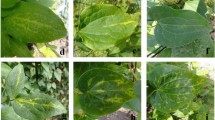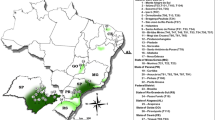Abstract
We collected samples from black, red and white currants showing symptoms of blackcurrant reversion disease (BRD) and full blossom disease (FBD), cultivated in the Czech Republic. Blackcurrant reversion virus (BRV) was detected in all symptomatic plants. After amplification, a substantial part of the 3′ non-translated region (3′-NTR) of RNA2 of 15 new isolates of BRV was sequenced and compared with sequences available in the literature and GenBank. We did not find significant sequence diversity among isolates associated with either FBD or BRD. BRV was graft-transmitted from FBD infected red currant to black currant where symptoms of BRD were observed. Further sequence analysis of BRV isolates resulted in a phylogenetic tree with four branches, each consisting of six to nine isolates. No correlation with geographic origin was visible on the tree as isolates from various countries occurred in all four branches. We also found no correlation between the host and the topology of the tree: most of black currant isolates occurred in branches 3 and 4, but also occurred in branches 1 and 2. Only one white currant and one red currant isolate occurred in branches 3 and 4, respectively. The sequence identity of the Czech isolates in this region ranged from 91.9 to 99.8%. The 17 plant species growing within and in the close vicinity of the BRD-infested plantation were tested negative for BRV by RT-PCR as natural hosts of BRV. BRV was successfully transmitted by mechanical inoculation from black currant to Nicotiana occidentalis and N. tabacum cv. Xanthi, the latter being a new host for BRV. The infection was confirmed by PCR and sequencing.





Similar content being viewed by others
References
Adams, A. N., & Thresh, J. M. (1987). Viruses and virus-like diseases of black currant mite-borne diseases. In R. H. Converse (Ed.), Virus diseases of small fruits (pp. 133–136). USDA Handbook 631.
Blattný, C. (1930). Poznámky o virových a příbuzných chorobách rostlin [Notes on virus and related diseases of plants]. Ochrana Rostlin, 10, 130–138 (in Czech).
Felsenstein, J. (1989). PHYLIP (Phylogeny inference package) version 3.6. Distributed by the author, Department of genetics, University of Washington, Seattle.
Jones, A. T. (2000). Black currant reversion disease – The probable causal agent, eriophyid mite vectors, epidemiology and prospects for control. Virus Research, 71, 17–84.
Karetnikov, A., Keränen, M., & Lehto, K. (2004). 3′ terminal sequences of Blackcurrant reversion virus (BRV) RNA2 are highly conserved in different virus isolates, and affect its translational efficiency. Acta Horticulturae, 656, 109–114.
Karetnikov, A., Keränen, M., & Lehto, K. (2006). Role of the RNA2 3′ non-translated region of Blackcurrant reversion nepovirus in translational regulation. Virology, 354, 178–191.
Latvala, S., Susi, P., Lemmetty, A., Cox, S., Jones, A. T., & Lehto, K. (1997). Ribes host range and erratic distribution within plants of Blackcurrant reversion associated virus provide further evidence for its role as the causal agent of reversion disease. Annals of Applied Biology, 131, 283–295.
Lehto, K., Lemmetty, A., & Keränen, M. (2004). The long 3′ non-translated regions of Blackcurrant reversion virus RNAs are highly conserved between virus isolates representing different phenotypes and geographic origins. Archives of Virology, 149, 1867–1875.
Lemmetty, A., Latvala, S., Jones, A. T., Susi, P., McGavin, W. J., & Lehto, K. (1997). Purification and properties of a new virus from black currant, its affinities with nepoviruses, and its close association with black currant reversion disease. Phytopathology, 87, 404–413.
Lemmetty, A., Latvala-Kilby, S., & Lehto, K. (2001). Comparison of different isolates of Blackcurrant reversion virus. Acta Horticulturae, 551, 45–49.
Lemmetty, A., & Lehto, K. (1999). Successful back-inoculation confirms the role of Black currant reversion associated virus as the causal agent of reversion disease. European Journal of Plant Pathology, 105, 297–301.
Lemmetty, A., Susi, P., Latvala, S., & Lehto, K. (1998). Detection of the putative causal agent of Blackcurrant reversion disease. Acta Horticulturae, 471, 93–98.
Přibylová, J., Špak, J., & Kubelková, D. (2002). Mixed infection of black currant (Ribes nigrum L.) plants with Blackcurrant reversion associated virus and Rhabdovirus-like particles with symptoms of black currant reversion disease. Acta Virologica, 46, 253–256.
Přibylová, J., Špak, J., Kubelková, D., & Lemmetty, A. (2001). The presence of Blackcurrant reversion virus in red and white currants with symptoms of full blossom disease. Acta Horticulturae, 656, 131–136.
Rakús, D. (1971). A new disease of red currant. Biológia, 26, 355–358 (in Slovak).
Rakús, D., Králík, O., & Brčák, J. (1974). Mykoplazma v Ribes houghtonianum Jancz. nakažené ‘plnokvětostí’ Sbor. ÚVTI–Ochrana rostlin, 10, 307–309 (in Czech, with English abstract).
Ritzema Bos, G. (1904). Eenige misvormingen of monstrositeiten [Some malformations and monstrosities]. Tijdschrift over Plantenziekten, 10, 135–144.
Susi, P. (2004). Black currant reversion virus, a mite transmitted nepovirus. Molecular Plant Pathology, 5, 167–173.
Špak, J., Navrátil, M., Karešová, R., Přibylová, J., Válová, P., Kučerová, J., et al. (2006). Occurrence, symptom variation and yield loss caused by full blossom disease in red and white currants in the Czech Republic. Crop Protection, 25, 446–453.
Acknowledgement
This research was supported by grant 1P050C051 from the Ministry of Education of the Czech Republic, COST Action 863 and grant AV0Z50510513 from the Academy of Sciences of the Czech Republic.
Author information
Authors and Affiliations
Corresponding author
Rights and permissions
About this article
Cite this article
Přibylová, J., Špak, J., Petrzik, K. et al. Sequence comparison and transmission of Blackcurrant reversion virus isolates in black, red and white currants with black currant reversion disease and full blossom disease symptoms. Eur J Plant Pathol 121, 67–75 (2008). https://doi.org/10.1007/s10658-007-9245-2
Received:
Accepted:
Published:
Issue Date:
DOI: https://doi.org/10.1007/s10658-007-9245-2




